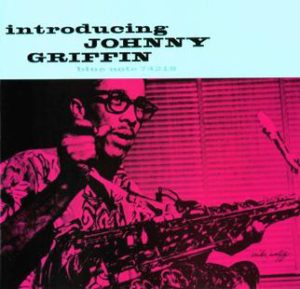It’s time to forge the fifth link in our Jazz Chain. This time our musician and band leader is Johnny Griffin, the tenor sax player from the last featured album, Wilbur Ware’s The Chicago Sound, and our focus is his debut album, Introducing Johnny Griffin.1Which is actually the 2nd recording session he led, but it was published before his true first stint as leader, Johnny Griffin. That album included both Wilbur Ware and Junior Mance, who played with Griffin on The Chicago Sound. Of course, this means we have now come to our first album to use the very common titling trope of using the Band Leader’s name.2The album which originally caught my eye as a possibility for this entry was 1978’s Return of the Griffin which combines both the SFF and band leader titling tropes, but it’s not the easiest to find, unfortunately. It won’t be the last.
Introducing Johnny Griffin – Johnny Griffin – 1957
This album features a nice little quartet. Joining Griffin are: Wynton Kelly3Who also appeared on Cecil Payne’s Zodiac, the third link in our chain. on piano, Curly Russel4An active sideman with many of the greats from ’45 – ’57, who never led his own album. on bass, and the great Max Roach5Legendary would probably be a more apt term. Considered one of the greatest and most important drummers of all time. I’ll probably always be more of an Art Blakey fan, but that doesn’t mean I don’t appreciate Roach too. on drums.
The main course here though, is definitely Griffin. Kelly gets a fair bit of feature time on piano, and he’s fine, but not as good or standout as he’s been other places. Roach and Russel pretty much stick to the6Always important. roll of a good rhythm section, with a few especially good Roach moments7The longest of which occur on The Way You Look Tonight, which was a bonus track added to the CD reissue, and included in the Spotify version I listened to.. No, this is definitely a tenor sax album featuring a top-tier tenor sax player. Griffin’s playing is8Even to this layman’s ears. a wonderful display of technical mastery. His sound is clear and the speed of the runs he can go on while maintaining articulation is really quite something and featured straight out of the gate on the album’s first track “Mil Dew”.9One of three Griffin originals on this album, along with “Chicago Calling” and “Nice and Easy” That clean, high-speed sound and technique shows itself through the album, with “It’s All Right With Me” being an especially good example10Both of these songs also feature short, but interesting, Max Roach moments. but there are also slower moments to sit back and enjoy that wonderful tenor sax sound that is part of what’s made it such a popular instrument over the years.
I don’t have any particular favorite tracks, nor do I think anything stands out as weak. It’s a good, solid, but perhaps not great album top to bottom and if you enjoy any kind of Bop I can’t see why you wouldn’t enjoy some time with this. I can definitely see it going in my rotation. And, as it was historically, it’s a good way to get acquainted with Johnny Griffin, who had a tremendous career as both a leader and sideman and is well worth exploring more.
Next time on the Jazz Chain we’re going to feature a Max Roach album11Though I almost feel bad passing over Wynton Kelly for the second time., because how could I not? There are so many great players in jazz history, but I can’t ignore the legendary tier Roach exists on.
If you’d like to see a list of all the posts for The Jazz Chain you can find them at this page.
If you’d like to listen to check out a playlist of all the albums featured on The Jazz Chain12Excepting those not available at Spotify, which is only one so far. you can check them out at this playlist here.

